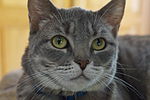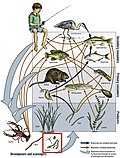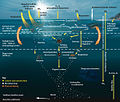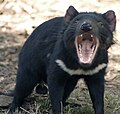Deimatic behaviour or startle display means any pattern of bluffing behaviour in an animal that lacks strong defences, such as suddenly displaying conspicuous...
23 KB (2,537 words) - 12:14, 4 June 2024
Camouflage Chromatophore Counter-illumination Countershading Crypsis Deimatic behaviour Disruptive coloration coincident Eyespot (mimicry) Mimicry Structural...
20 KB (2,385 words) - 22:43, 29 September 2024
Defense, counter Animal coloration Anti-predator adaptations Camouflage Deimatic behaviour Herbivore adaptations to plant defense Mimicry Plant defense against...
31 KB (3,540 words) - 04:52, 14 September 2024
Banded bullfrog (section Behaviour and ecology)
and snails such as the golden apple snail. Banded bullfrogs display deimatic behaviour when threatened, greatly inflating their bodies in an attempt to distract...
28 KB (2,972 words) - 01:14, 19 July 2024
Anti-predator adaptation (redirect from Antipredator behaviour)
1017/S1464793105006810. PMID 16221330. S2CID 24868603. Edmunds, Malcolm (2012). "Deimatic Behavior". Springer. Retrieved 31 December 2012. Smith, Ian (3 December...
53 KB (5,777 words) - 20:03, 24 October 2024
Octopus (section Behaviour and ecology)
mimicry; some have conspicuous warning coloration (aposematism) or deimatic behaviour (“bluffing” a seemingly threatening appearance). An octopus may spend...
116 KB (12,065 words) - 08:58, 3 November 2024
black-faced impala stotting in Namibia An impala stotting Aposematism Deimatic behaviour "Definition of stot". www.allwords.com. "pronk". A Dictionary of South...
10 KB (1,211 words) - 19:28, 2 April 2024
Deimatic behaviour of the mantis Oxyopsis sp....
10 KB (746 words) - 02:05, 12 December 2023
predator. This gives the prey animal an opportunity to escape. The behaviour is deimatic (startling) rather than aposematic as these insects are palatable...
49 KB (5,274 words) - 15:11, 25 August 2024
its arms. When it is disturbed, its colour becomes more intense, deimatic behaviour which may make it appear threatening to a potential predator. Populations...
7 KB (701 words) - 22:16, 18 February 2022
(PDF) on 4 March 2016. Retrieved 23 June 2015. Miklósi, Adám (2009). Dog Behaviour, Evolution, and Cognition. Oxford University Press. doi:10.1093/acprof:oso/9780199295852...
55 KB (6,713 words) - 02:07, 7 November 2024
PMID 15889076. S2CID 4408533. Novales Flamarique, Iñigo (2019). "Swimming behaviour tunes fish polarization vision to double prey sighting distance". Scientific...
66 KB (7,935 words) - 05:23, 5 November 2024
Startle may also refer to: Startle display or deimatic behaviour, any pattern of bluffing behaviour in an animal that lacks strong defences Startle...
653 bytes (124 words) - 16:25, 24 March 2020
[Description of Physalaemus deimaticus, sp. n., and observations on the deimatic behaviour in P. nattereri (Steindn.) — Anura, Leptodactylidae]. Revista de Biologia...
5 KB (420 words) - 20:10, 23 August 2024
species that actions like these can startle predators such as lizards (deimatic behaviour), and it is believed this is the case in the stick insect as well...
3 KB (392 words) - 10:57, 15 August 2024
releasing chemical compounds, modifying abiotic factors, or affecting the behaviour of herbivores, impacting on other species. Some, like Kalanchoe daigremontana...
128 KB (13,125 words) - 21:30, 27 October 2024
Idolomantis (section Behaviour)
of the insect. When confronted by a predator, I. diabolica initiates a deimatic display in an attempt "to scare off or momentarily distract a predator"...
10 KB (902 words) - 16:21, 29 December 2023
for gaining insight into the structure, stability, and laws of food web behaviours relative to observable outcomes. "Food web theory centers around the idea...
82 KB (8,605 words) - 01:06, 24 October 2024
Defense, counter Animal coloration Anti-predator adaptations Camouflage Deimatic behaviour Herbivore adaptations to plant defense Mimicry Plant defense against...
161 KB (16,691 words) - 07:21, 8 October 2024
the forewing, enabling the insect to switch rapidly from cryptic to deimatic behaviour. Some hemipterans such as firebugs have bold aposematic warning coloration...
68 KB (6,798 words) - 22:40, 4 November 2024
Defense, counter Animal coloration Anti-predator adaptations Camouflage Deimatic behaviour Herbivore adaptations to plant defense Mimicry Plant defense against...
22 KB (2,276 words) - 10:09, 13 July 2024
of its mouth, for any of various purposes. This may be a form of deimatic behaviour, colloquially known as a startle display or threat display, as it...
4 KB (530 words) - 17:48, 17 August 2023
theory Anti-predator adaptation Alarm signal Aposematism Apparent death Deimatic behaviour Distraction display Crypsis Camouflage Mimicry Unkenreflex...
10 KB (1,098 words) - 19:41, 24 August 2024
Camouflage Chromatophore Counter-illumination Countershading Crypsis Deimatic behaviour Disruptive coloration coincident Eyespot (mimicry) Mimicry Structural...
19 KB (2,503 words) - 08:40, 12 July 2024
Defense, counter Animal coloration Anti-predator adaptations Camouflage Deimatic behaviour Herbivore adaptations to plant defense Mimicry Plant defense against...
13 KB (1,391 words) - 17:53, 31 December 2023
theory Anti-predator adaptation Alarm signal Aposematism Apparent death Deimatic behaviour Distraction display Crypsis Camouflage Mimicry Unkenreflex...
18 KB (2,127 words) - 20:27, 17 October 2024
Defense, counter Animal coloration Anti-predator adaptations Camouflage Deimatic behaviour Herbivore adaptations to plant defense Mimicry Plant defense against...
5 KB (719 words) - 16:38, 26 April 2024
Iris oratoria (section Behaviour)
is known for two distinctive behaviours, apart from the ambush hunting common to other mantids: cannibalism and deimatic or threat displays. The sexual...
12 KB (1,103 words) - 20:11, 13 September 2024
large and heavy for their wings to enable a take-off. Mantids show strong deimatic display from very early life stages on. This behavior can be observed throughout...
35 KB (4,263 words) - 06:59, 2 November 2024



























